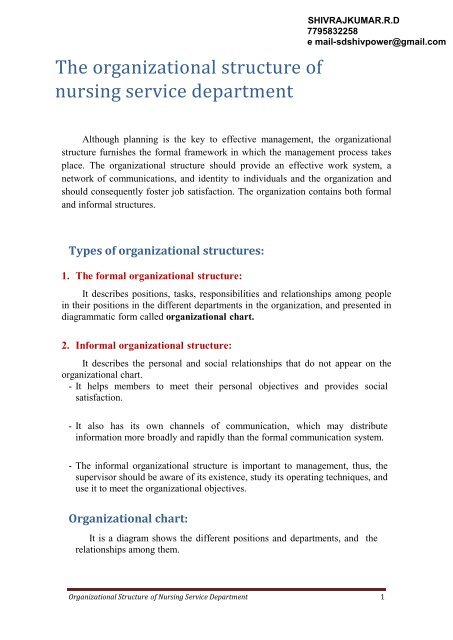The organizational structure of nursing service department
Describes about the nursing services in a hospital and also the whole structure of the hospital services
Describes about the nursing services in a hospital and also the whole structure of the hospital services
You also want an ePaper? Increase the reach of your titles
YUMPU automatically turns print PDFs into web optimized ePapers that Google loves.
<strong>The</strong> <strong>organizational</strong> <strong>structure</strong> <strong>of</strong><br />
<strong>nursing</strong> <strong>service</strong> <strong>department</strong><br />
SHIVRAJKUMAR.R.D<br />
7795832258<br />
e mail-sdshivpower@gmail.com<br />
Although planning is the key to effective management, the <strong>organizational</strong><br />
<strong>structure</strong> furnishes the formal framework in which the management process takes<br />
place. <strong>The</strong> <strong>organizational</strong> <strong>structure</strong> should provide an effective work system, a<br />
network <strong>of</strong> communications, and identity to individuals and the organization and<br />
should consequently foster job satisfaction. <strong>The</strong> organization contains both formal<br />
and informal <strong>structure</strong>s.<br />
Types <strong>of</strong> <strong>organizational</strong> <strong>structure</strong>s:<br />
1. <strong>The</strong> formal <strong>organizational</strong> <strong>structure</strong>:<br />
It describes positions, tasks, responsibilities and relationships among people<br />
in their positions in the different <strong>department</strong>s in the organization, and presented in<br />
diagrammatic form called <strong>organizational</strong> chart.<br />
2. Informal <strong>organizational</strong> <strong>structure</strong>:<br />
It describes the personal and social relationships that do not appear on the<br />
<strong>organizational</strong> chart.<br />
- It helps members to meet their personal objectives and provides social<br />
satisfaction.<br />
- It also has its own channels <strong>of</strong> communication, which may distribute<br />
information more broadly and rapidly than the formal communication system.<br />
- <strong>The</strong> informal <strong>organizational</strong> <strong>structure</strong> is important to management, thus, the<br />
supervisor should be aware <strong>of</strong> its existence, study its operating techniques, and<br />
use it to meet the <strong>organizational</strong> objectives.<br />
Organizational chart:<br />
It is a diagram shows the different positions and <strong>department</strong>s, and the<br />
relationships among them.<br />
Organizational Structure <strong>of</strong> Nursing Service Department 1
It is used to show:<br />
<strong>The</strong> formal <strong>organizational</strong> relationships.<br />
Areas <strong>of</strong> responsibility.<br />
Persons to whom one is accountable.<br />
Channels <strong>of</strong> communication.<br />
Types <strong>of</strong> <strong>organizational</strong> charts:<br />
<strong>The</strong>re are three types <strong>of</strong> <strong>organizational</strong> charts: the vertical, the<br />
horizontal, and circular charts.<br />
1. Vertical charts:<br />
It shows high-level management at the top with formal lines <strong>of</strong><br />
authority down the hierarchy, are most common (fig. 8).<br />
Board <strong>of</strong> directors<br />
Hospital administration<br />
Director <strong>of</strong> Nursing<br />
Supervisor <strong>of</strong> Nursing<br />
Supervisor <strong>of</strong> Nursing<br />
Head Nurse<br />
Head Nurse<br />
Head Nurse<br />
Head Nurse<br />
Staff Nurse<br />
Staff Nurse<br />
SN<br />
SN<br />
SN<br />
SN<br />
SN<br />
SN<br />
Fig. 8 Vertical <strong>organizational</strong> Chart<br />
Organizational Structure <strong>of</strong> Nursing Service Department 2
2. A left-to-right (horizontal) charts:<br />
It shows the high-level management at the left with lower positions to<br />
the right. Shows relative length <strong>of</strong> formal lines <strong>of</strong> authority, helps<br />
simplify understanding the lines <strong>of</strong> authority and responsibility<br />
(fig. 9).<br />
Staff<br />
Nurse<br />
Board <strong>of</strong><br />
Directors<br />
Hospital<br />
Administrator<br />
Director <strong>of</strong><br />
Nursing<br />
Supervisor<br />
Supervisor<br />
Fig. 9 Left-to-right (Horizontal) <strong>organizational</strong> Chart<br />
Head<br />
Nurse<br />
Head<br />
Nurse<br />
Head<br />
Nurse<br />
Head<br />
Nurse<br />
Staff<br />
Nurse<br />
Staff<br />
Nurse<br />
Staff<br />
Nurse<br />
Staff<br />
Nurse<br />
Staff<br />
Nurse<br />
Staff<br />
Nurse<br />
Staff<br />
Nurse<br />
3. Circular charts:<br />
It shows the high-level management in the center with successive<br />
positions in circles. It shows the outward flow <strong>of</strong> formal authority from the<br />
high-level management. It reduces status implications (fig. 10).<br />
Characteristics <strong>of</strong> an effective <strong>organizational</strong> chart:<br />
1. Be accurate, clear, simple and updated.<br />
2. Shows the chain <strong>of</strong> command, lines <strong>of</strong> authority, responsibility<br />
and relationships.<br />
3. All members <strong>of</strong> the <strong>department</strong> should be notified when any<br />
change occurs.<br />
Organizational Structure <strong>of</strong> Nursing Service Department 3
Staff<br />
Nurse<br />
Staff<br />
Nurse<br />
Head<br />
Nurse<br />
Head<br />
Nurse<br />
Staff<br />
Nurse<br />
Staff<br />
Nurse<br />
Board <strong>of</strong><br />
Directors<br />
Supervisor<br />
Hospital<br />
Administrator<br />
Supervisor<br />
Staff<br />
Nurse<br />
Head<br />
Nurse<br />
Director <strong>of</strong><br />
Nursing<br />
Head<br />
Nurse<br />
Staff<br />
Nurse<br />
Staff<br />
Nurse<br />
Staff<br />
Nurse<br />
Fig. 10 Circular Organizational Chart<br />
Principles for drawing an accurate <strong>organizational</strong> chart:<br />
<strong>The</strong> chart should have a clear title.<br />
It should be dated.<br />
<strong>The</strong> higher management should be shown at the top, while most junior<br />
positions at the end <strong>of</strong> the chart.<br />
Positions <strong>of</strong> equal seniority should be shown at the same level.<br />
For clarity, details should be well spaced.<br />
Organizational Structure <strong>of</strong> Nursing Service Department 4
Page 5/5<br />
Solid lines must be used to indicate flow <strong>of</strong> authority; staff relationships<br />
can be shown by a dotted line.<br />
Colors may be used to distinguish between <strong>department</strong>s.<br />
Advantages <strong>of</strong> an <strong>organizational</strong> chart:<br />
1. It provides a quick visual illustration <strong>of</strong> the <strong>organizational</strong> <strong>structure</strong>.<br />
2. It provides help in <strong>organizational</strong> planning.<br />
3. It shows lines <strong>of</strong> formal authority, responsibility and accountability.<br />
4. It clarifies who supervises whom and to whom one is responsible.<br />
5. It emphasizes the important aspect <strong>of</strong> each position.<br />
6. It facilitates management development and training.<br />
7. It is used to evaluate strengths and weakness <strong>of</strong> current <strong>structure</strong>.<br />
8. It provides starting points for planning <strong>organizational</strong> changes.<br />
9. It describes channels <strong>of</strong> communication.<br />
Disadvantages:<br />
1. Charts become outdated quickly.<br />
2. Does not show informal relationship.<br />
3. Does not show duties and responsibilities.<br />
4. Poorly prepared charts might create misleading effects.<br />
Organizational Structure <strong>of</strong> Nursing Service Department 5


